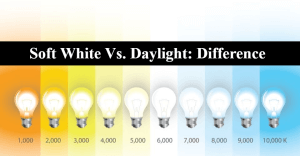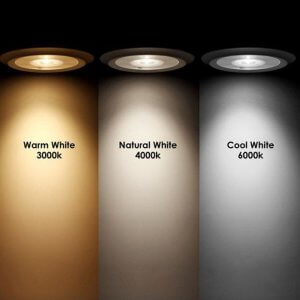A soft white or daylight when illuminated can alter the perception of an object or a space. However, when you compare soft white vs daylight there is a huge difference between the two.
Nevertheless, if you want your application to succeed, it is vital to choose the right option for your particular case.
The terms soft white and daylight can both be used interchangeably. Warm light vs cool light would be another way to think about it. One could even look at it from a different perspective, 2700K vs 6000K.
This is what we’re talking about, two very different color temperatures that sit on the opposite ends of the scale when it comes to color temperature.
In addition to that, there is literally a scale that can be applied to these LED light colors as well. This scale is called the Kelvin scale.
Kelvin scales range from 1,000K all the way up to 10,000K. The lower the Kelvin scale, the yellower the tone. A higher Kelvin scale indicates a more blueish tone.

- Daylight = 6500K-7500K
- Soft White = 3500K-4500K
Table of Contents
Soft White vs Daylight
In comparing Soft white vs daylight, it’s pretty clear that there’s a huge difference between the two.
The color range of soft white is often yellow and has more warm tones. In contrast, daylight is much cooler and has a much higher level of white and even blueish hues.
This is a warm, soft white that is perfect for residential environments and has more earthy undertones.
White with a blue undertone is ideal for commercial environments, unlike bright white which has a more yellow undertone.
Those of you who are on the fence can compare not only 3000K vs 4000K options but also 4000K vs 5000K options.
In terms of color temperature, there’s a slight difference between these three ranges, but this is where most consumers will find a nice match for many different applications.
Soft White is an excellent choice for:
- Under Cabinets
- Residential
- Kitchen
- Bathrooms
- Bedrooms
- Closets
Daylight is an excellent choice for:
- Display Cases
- Signage
- Commercial
- Garages
- Offices
Soft White vs Daylight: Which is Best for Bathrooms?
You want a brighter light in the majority of bathroom and vanity applications. It is preferable to choose a color temperature range that is between 3000K (soft white) and 5000K (cool white) for a bathroom.
It has been mentioned that daylight can sometimes be too blue and sterile. I usually prefer to err on the side of soft white vs daylight since it is more to my liking.
You should keep in mind that soft white is about 3000 K, which is recommended for earthy tones and will highlight the wood grain, while daylight is about 6000 K, which is more blue-tinted and may be a better choice for commercial settings.

There are a few things you should keep in mind:
- Size of the room
- Countertop color
- Cabinetry color
- Existing natural light
- Paint color
Both the 3000K and 6000K light bulbs were tested on a standard gloss taupe color painted wall in my bathroom.
In the comparison of soft white vs daylight it is evident that there is a significant difference between the two lights, as you can see below. There is no doubt in my mind that the soft color is more pleasing, however, it is obvious that the daylight contributes quite a bit more ‘brightness’.
There’s no doubt that meeting in the middle might be the most convenient for many of us. I think a 4000K color would make a nice overall tone.
Soft White vs Daylight: Which is best for Kitchens?
If you have a traditionally styled or transitional kitchen, then you should use a soft white light. A warmer light has the advantage of being less harsh than a daylight fixture. A warmer light has the advantage of highlighting wood grain, while blending well with earthy tones.
For a more modern kitchen, you may want to look for a light that is a “cool white” light between 4000K and 5000K. As compared to a daylight color of 6000K, which is usually harsher and has a blueish tint to it, this is usually much improved.
Make sure you use a daylight fixture in your kitchen so that you do not create the impression that it is sterile and unwelcoming for your guests.
Alternatively, you could use a cool white in the middle or a soft white in the middle.
On my older wood veneer cabinets with darker shades of wood veneer, both the 3500K and 6500K lamps were tested.
I was surprised how pleasant the soft white shade of the 3000K lamp was.
However, I felt the much brighter 6000K was too aggressive and didn’t stand out as much as the 4000K.
I guess that’s the price of brightness. As far as I am concerned, the daylight color temperature actually provides a more task-oriented light, which is essential in a kitchen. In addition, the soft white color makes the wood grains and cabinets appear more natural because of the soft appearance.
I am quite pleased with the result. You should definitely consider the color of your cabinets. You would be surprised at how important this really is and even if you have white contemporary cabinets, make sure there is a light that is a cool white, but not daylight.
Soft White vs Daylight: Which is best for Bedrooms?
Typically, our bedrooms are places where we go to relax and wind down at the end of the day. In ideal circumstances, the recommended color temperature for bedrooms should be a warm, yellowish light rather than a bright white light. The color temperature for your lights should range from 2000K to 3500K.
Most of us would enjoy basking in the daylight sun for as long as we can.
Nevertheless, it is not a color that it is pleasant to have in a bedroom when it comes to the term “daylight” in lighting. The light can be very harsh and very bright, with a blueish tinge to it.
For the purpose of making your bedroom a warm and comfortable place, stick with the tried-and-true color of warm white for the purpose of lighting.
I took some pictures of my lamp with different types of bulbs in it, and I thought you might like to see them. Having the lamp cover disperse yellow hues in the soft white light and blue hues in the daylight light, it is easy to ascertain the difference between the two.
Soft White Lights
One of the most popular colors that you can choose for residential applications is soft white. I would consider it to be a warm white, or a 2700K-3000K white as well. It has become apparent to me that soft white tones just work better in the most places than a daylight bulb.
The following are some examples of soft white light fixtures that you can use:
- Recessed Ceiling Lights
- Puck and Stick Lights
- Outdoor Sting Lights
- LED Light Bulbs
- Incandescent Bulbs
- LED Strip Lights
Daylight Lights
A daylight fixture is one of the most common types of fixtures that you can easily find when you shop around for one.
With the help of tunable lights, you can switch between daylight and soft white light in some cases, such as with smart bulbs.
Among the different kinds of daylight fixtures that you can get are:
- Puck Lights
- Ceiling Lights
- LED Strip Lights
- Incandescent Bulbs
- Stick Lights
- LED Light Bulbs
Let Your Style Shine!
Which is the best thing about choosing a light’s color temperature?
In order to answer this question, it is quite impossible to put forth a single answer. Yes, there are some good guidelines you can follow, but ultimately it comes down to your personal preferences.
It is always a good idea to test different combinations of light and color when it comes to lighting. As a result, you might find that you really like something that you didn’t expect to.
Read More:
- Verizon Router Showing Red Globe – 5 Methods To Fix 2022
- Roku Overheating? – Multiple Solutions [Updated Guide 2022]
- Samsung TV Blue Screen? – Here is How To Fix Updated Guide 2022
- How to Prop Up a TV Without a Stand – 2022 Updated Guide
- PS4 Controller Orange Light – What Does It Mean and How Can It Be Fixed?
- 120Hz Vs 144Hz Monitor – Which One Should You Buy? [2022 Guide]
